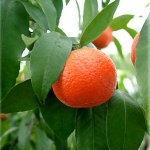| Common Name: |
Mandarin |
| Botanical Name: |
Citrus nobilis |
| Family: |
Rutaceae |
| Location: |
United States, Algeria, Brazil, California, Cyprus, Florida, Greece, Italy, Spain, Texas. |
| Extraction: |
Expression |
| Parts Used: |
Peel |
| Color and Odor: |
The essential oil is golden yellow in color and has a delicate, sweet (almost floral) aroma reminiscent of the fruit itself. |
| Background: |
Originating in China, where it is traditionally very important, the fruit was named after the Chinese mandarins. It was introduced to Europe at the beginning of the nineteenth century and to the Americas about a half century later. |
| Properties: |
Antispasmodic, cytophyactic, digestive, sedative, tonic. |
| Planet: |
|
| Element: |
|
| Direction: |
|
| Magical Influences: |
|
| Uses: |
- Digestive System—Aids digestion as it calms the intestines but acts as a tonic for the stomach and the liver. Gentle action suitable for hiccups.
- Skin—Promotes cell regeneration; excellent for pregnancy, prevents stretch marks.
- Emotions—Fresh, subtle, sympathetic, inspiring, strengthening.
|
| Blends: |
| Bibliography: |
Aromatherapy Blends and recipes by Franzesca Watson Copyright © 1995 Thorsons, Harper Parker Publishing Inc. Pp 128-129
|
|

